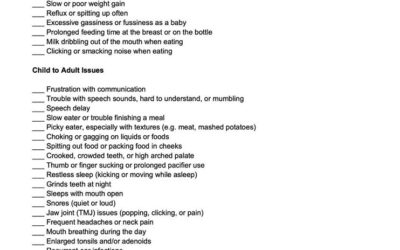Articles
Tongue- and lip-tie issues can be complex.
We’re here to present the latest thinking on tongue-ties in a clear and easy-to-read format. We hope these thoughts are helpful whether you are a patient, professional, or family member as you learn more on your journey. For more insights, go to TongueTie.com.
What Symptoms Does a Tongue-Tie Cause?
Tongue-Tie Tips #2 This week, we’re going to talk about symptoms a tongue-tie can cause. Did any of you check for restricted tongues on your patients last...
Tongue-Tie Tips #1
Tongue-Tie Tips #1 Hello everyone! I am going to be posting pearls every week to help you identify patients with tongue restrictions, and in the coming weeks...
4 Ways To Tell If Your Child Has A Tongue-Tie And What To Do About It
It seems that everywhere you read online, a tongue-tie seems to be one of the first issues suggested when babies can’t eat or kids can’t speak well. Let’s go...
COVID-19 UPDATE 4/30/20
We will be open treating all patients starting on Monday, May 4! We have our team members here today and Friday answering your calls to schedule an...
Top 8 Myths About Tongue-Tie Treatment
These tongue-tie myths are repeated all too often. Medical professionals, dental professionals, therapists, friends, and family are prone to repeat these myths when they have not had up-to-date education on the topic. Educate yourself and others, or check out our longer articles on the subject, Part 1 and Part 2. 1. “A Clip or a Snip with Scissors Is Enough” Often a snip or clip leaves thick tissue behind and will need a second proper release. The patient often sees some improvement, but the standard “clip” without post-op exercises is likely to be incomplete or grow back. A full release of restricted fascia will allow better function and symptom resolution. The laser allows complete visualization of the surgical area with typically no bleeding and ultimate precision, so we get all the tight tissue while protecting important structures under the tongue. 2. “The Tongue-Tie Will Stretch Out” The tongue-tie is comprised of a thick webbing of fascia (mainly type 1 collagen fibers) that stretches less than 1%. If left untreated, it will persist into adulthood, and although some children can remarkably compensate with a tight tongue, no child should have to miss out on proper development and struggle with daily […]
“The Tongue-Tie Will Stretch Out” And Other Common Myths, Part 2.
Read the first four myths here. Myth #5: “The tongue-tie will stretch, or the child will fall and break it, so it doesn’t need to be treated.” That would be nice if it just stretched out, so we could “wait and see.” Unfortunately, this is not the case. The frenum is made of a thick webbing of fascia (connective tissue) that is itself made of dense type 1 collagen bundles, which happens to be resistant to stretching. So the most stretching you might get would be 1%, but it will not disappear, stretch out, or change over time without intervention. 38 year old with a to-the-tip tie. She did not have speech difficulty, but she had many other issues she didn’t know were related. If your fingers are stuck together, they will not separate magically. Neither will a tongue-tie. We see 30-year-olds, 50-year-olds, even 70-year-olds still with a tight-as-ever tongue-tie. You can certainly survive with a tongue-tie, but you may have compromised function and difficulty with chewing, speech, and sleep; neck and shoulder pain; and even headaches. 36 year old who was “clipped” as a baby. And after a proper release. A child may fall and rip the lip […]
“They Will Just Laser Everyone,” And Other Common Myths, Part 1.
Myth #1: “They will just laser everyone.” First off, we do not use a lightsaber! We use an ultra-precise surgical CO2 laser that looks like a pen and doesn’t even touch the tissue. It removes tissue layer by layer, and allows us to see all the restriction and remove it safely, quickly, and as gently as possible. Just the other day, a patient told us that their pediatrician thinks we will “find something to cut on everyone.” So don’t go for a consult, they said. The well-meaning provider will tell the parent that instead of being evaluated for a tie, they should try other things instead. Give the struggling baby a bottle, give formula, take reflux medication (off-label, and has side effects), or “just give it time.” These suggestions address the symptoms, but not the root cause. Tongue restrictions are widespread, affecting around 20% of babies, but most go undiagnosed, and only the symptoms are treated. We do not laser everyone that comes to see us. We perform a careful evaluation and listen to mom tell her full story and the child’s story. After understanding all the details and doing an exam, we are in a better position to make […]
Are Too Many Babies Getting Their Tongues Clipped? The Real Story.
If you read the news headlines, it sure sounds like it! A recent article came out in the Journal of the American Medical Association (JAMA – ENT), which is a high impact journal. The article discussed looking into different reasons for feeding problems in infants, and still recommended many of them to have tongue-tie releases. Unfortunately, the news media spun the article as “Babies ‘Don’t Need Tongue-Tie Surgery to Feed’” from the BBC. Others from Today, NYT, etc. all said virtually the same thing; babies don’t need their tongue’s clipped. I agree- they don’t need a clip, they need a full release, as discussed in a previous post. But these people are actually arguing that we should leave a known physical barrier to normal development and life skills in children with diagnosed feeding problems. If there is a problem with feeding, the article suggested giving reflux medication, pushing them on the boob harder, tapping their feet or using a cold washcloth on the baby to wake it up… They are treating symptoms of tongue-tie problems instead of the ROOT cause – THE RESTRICTION! If a child had webbed fingers, their fingers were fused together, no one would argue to leave them […]
Don’t Get That Tongue-Tie Clipped or Snipped… Get a Full Release Instead.
What is a full tongue-tie release? Hint: It’s not a clip or a snip! I don’t like the term “clip” or “snip.” Those are four-letter words to me. If I hear a baby or child was clipped or snipped, about 95% of the time it wasn’t enough. Normally a clip or snip is performed by a provider at the hospital or in the office (ENT or pediatrician), or while the child was put to sleep (it’s not necessary to put kids to sleep for this procedure, but that’s another topic). Warning images of tongues ahead… The proper term is really a release of the tight tissue, so providers who are up-to-date will call the procedure a “release” instead of clip or snip. The concept that treating a tongue-tie is “no big deal” is what leads to the problem with the clip. If they do a clip, they will almost always cut halfway with scissors, and leave a thick band of tissue. If it’s cut halfway, it will work half the time. They think they are getting it all, but in reality, if you were to lift up on the tongue, it ends up looking like this: See that thick […]








